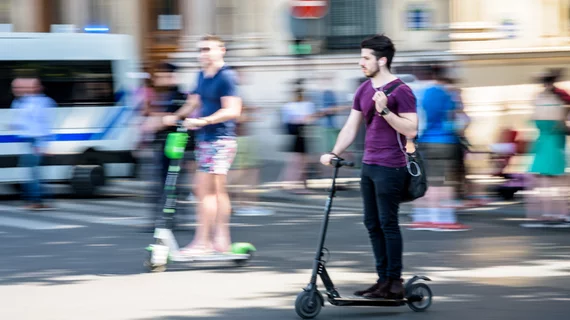E-scooter study finds more injuries in CT scans and x-rays
A significant portion of people who undergo a CT scan or x-ray after an electric scooter accident had injuries, according to a study presented at the 2019 Radiological Society of North America (RSNA) annual meeting in Chicago.
In fact, the injuries were most commonly found in the upper extremities. The study underscores a greater need for public education and research about the use of dockless motorized rental scooters, or e-scooters, which have been popping up as affordable transportation options in some cities in the U.S.
E-scooters have been billed as an alternative to public transportation and bicycles. At the same time, the number of reported injuries associated with e-scooters has risen, as well as the number of imaging exams.
"We believe that many users are not fully aware of the potential significant injuries that may occur with e-scooter use," study author Mohsin Mukhtar, MD, of the Indiana University School of Medicine, said in a statement. "Raising awareness and doing further research on this topic could inform future policy."
For example, imaging exams at Indiana University Health System “spiked” in the aftermath of the legalization of the scooters in Indianapolis in September 2018, according to the release. The trend prompted IU School of Medicine researchers to analyze electronic medical records and radiology archives for people 18 and older who had exams for a scooter-related injury.
"E-scooters have a narrow platform, can travel up to 15 to 20 miles per hour and require a level of coordination and skill that is often not native to many users," study co-author Aiza Ashraf, MD, diagnostic radiology resident at the Indiana University School of Medicine, said in a statement. "Whereas physical effort is required to get a bicycle up to speed, e-scooters are self-powering."
Ashraf and colleagues looked at 69 exams performed on 36 unique emergency department patients with the involvement of an e-scooter over a five-year period. Nineteen patients were male and 17 were female, with the majority being between 18 and 30 years old. The patients most commonly had x-rays of their extremities and CT scans of their head, face and cervical spine performed.
Out of the 36 patients, 19 had a radiographically apparent injury, most commonly a wrist injury, including six fractures of the forearm bone close to the wrist. Five cases also found soft tissue injuries of the head, face, wrist and ankle.
According to the researchers, helmets and hand/wrist guards could help prevent some of the injuries, and the study highlights the importance of protective gear when it comes to e-scooter use. In addition, they underscored the dangers of e-scooter use while intoxicated. They also noted that e-scooter companies should consider lowering or imposing speed limits on their devices. Further studies are recommended and needed to examine the full public health impact and safety concerns of e-scooters.
“Limiting e-scooter speed could reduce the overall incidence and severity of injuries in the event of a fall or collision," Ashraf said. "And since these e-scooters could be viewed as a potential public health hazard, we would recommend public education on the use of these devices."

